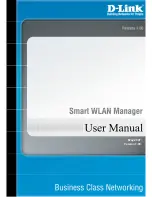
63
Appendix B Glossary
Access Point -
An internetworking device that seamlessly connects wired and wireless networks together.
Ad-Hoc -
An Ad-Hoc wireless LAN is a group of computers each with wireless adapters, connected as an
independent wireless LAN without an access point to make point-to-point wireless communication.
ATIM
– It means "Announcement Traffic Indication Message". A station may enter power save mode if and only if
the value of the ATIM Window in use within the IBSS (in Ad hoc mode) is greather than zero. If this
value is NULL, no power management is used within IBSS created by the station.
Authentication Type
– The Authentication Type controls the WEP key validation during the authentication of
a station by the access point. When the Shared Key option is selected, the access point will validate that
the station is using the same WEP key with it. This procedure goes like this: the access point sends a
known unencrypted packet to the station. The station encrypts this packet and sends it back to the
access point. The access point tries to decrypt this packet and then sends an Authentication response
packet to the station indicating the success or failure of this process. On the other hand, under Open
Authentication, there is no check for a matching WEP key.
Backbone -
The core infrastructure of a network, the portion of the network that transports information from one
central location to another central location. The information is then off-loaded onto a local system.
Base Station -
In mobile telecommunication, a base station is the central radio transmitter/ receiver that
maintains communication with the mobile radio telephone sets within range. In cellular and personal
communications applications, each cell or microcell has its own base station; each base station in turn
is interconnected with other cells’ base.
BSS -
Stands for “Basic Service Set.” An Access Point associated with several wireless stations.
ESS -
Stands for “Extended Service Set.” More than one BSS can be configured as an Extended Service Set. An
ESS is basically a roaming domain.
Ethernet -
A popular local area data communications network, originally developed by Xerox Corp., which
accepts transmission from computers and terminals. Ethernet operates on 10 Mbps baseband
transmission over shielded coaxial cable or over shielded twisted pair telephone wire.
Fragmentation Threshold
– The Fragmentation Threshold defines the number of bytes used for the
fragmentation boundary for directed messages. The purpose of "Fragmentation Threshold" is to
increase the transfer reliability thru cutting a MAC Service Data Unit (MSDU) into several MAC Protocol
Data Units (MPDU) in smaller size. The RF transmission can not allow to transmit too big frame size due
to the heavy interference caused by the big size of transmission frame. But if the frame size is too small,
it will create the overhead during the transmission.
Infrastructure -
An integrated wireless and wired LAN system is called an Infrastructure configuration.
Listen Interval
–
The Listen Interval field is used to indicate to the AP how often a station wakes to listen to
Beacon managemetn frames. The value of this parameter is the station's Listen Interval MIB attribute
and is expressed in units of Beacon Interval. The length of the Listen Interval decides the wake up time
to listen to Beacon management. Longer Listen Interval decreases the performance and shorter interval
decreases power saving function.
PCMCIA -
Personal Computer Memory Card International Association, which develops standards for PC cards,
formerly known as 11Mbps RF Modules, are available in three “types” which are about the same length
and width as credit cards, but range in thickness from 3.3 mm (Type I) to 5.0 mm (Type II) to 10.5 mm


































